Hi! I’mm Alastair, an adventurer and author. I invented the phrase #Microadventure and I’mve been shouting about it for a few years. You can follow the microadventures people are doing on social media here or say hello to me here.
This post will teach you everything about bivvy bags ready for your microadventure. If you’re looking for microadventure ideas try the Year of Microadventure Challenge, watch a few videos of my microadventures or -best of all- buy a signed copy of the best-selling Microadventures book!
This is a tent:
For overnight microadventures, however, I encourage people to try using a bivvy bag instead.
What is a bivvy bag and why do you recommend it?
- A bivvy bag is like a waterproof jacket for your sleeping bag. It’s a thin, waterproof bag. You use it over the top of your sleeping bag.
- A bivvy bag is cheaper than a tent.
- It’s a lot smaller than a tent.
- It’s very discreet and allows you to sleep on tiny patches of flat ground.
- You are not cocooned from the environment as you are in a tent. In a tent you are basically in a rubbish version of indoors. In a bivvy bag you really are outside. You feel the breeze on your face, look up at the stars before you sleep and sit up to a brilliant view in the morning.
- It feels more exciting and more wild than a tent.
- Here is a picture of a bivvy bag to give you an idea of how small they are:
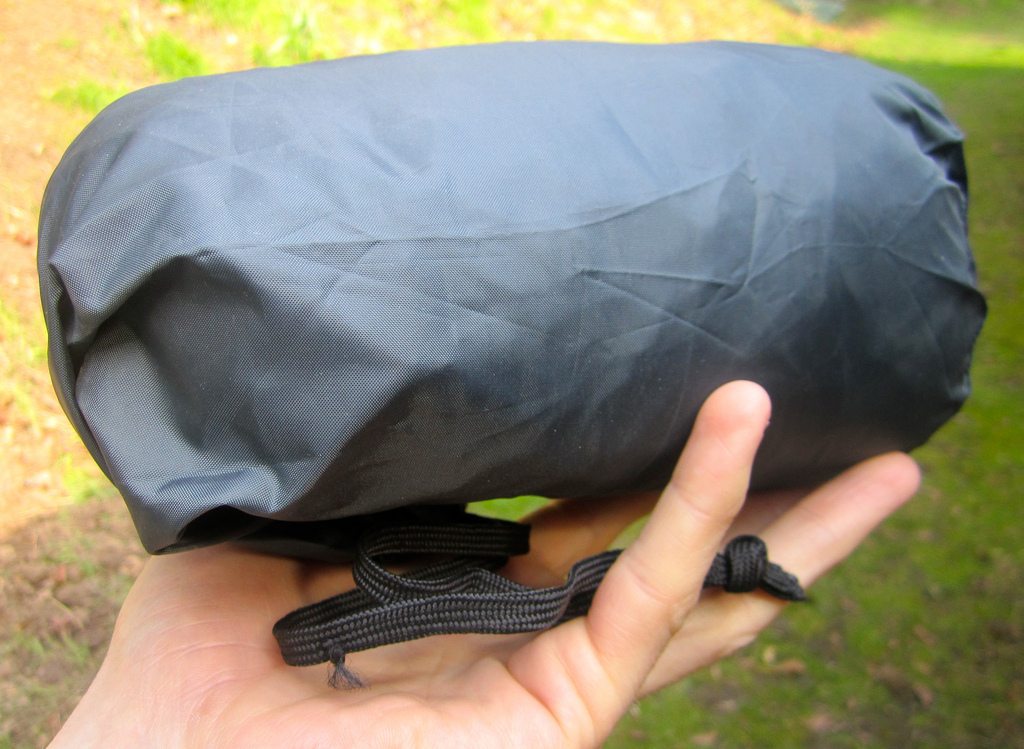
What are the disadvantages of a bivvy bag?
- If it rains you will have a less pleasant night than if you were in a tent / 5 star hotel. (Taking a basha will help a lot though. Here is the extra gear you should pack if you think it might rain.)
- Even the best bivvy bags leave some condensation on your sleeping bag. For a single-night trip this is no problem, but for extended use you need to be able to hang your sleeping bag up to dry occasionally.
How do I use a bivvy bag?
- Just slip it over your sleeping bag. If I am organised I do this before leaving home rather than doing it later in the dark and pouring rain.
- Pull it up over your head when you sleep. Just leave a small gap for your mouth to breathe out of in order to minimise the condensation.
- I tend to leave my sleeping mat on the outside. If the weather is foul or if you have a large bivvy bag you can experiment with putting it inside the bivvy bag.
- Remember to take a large waterproof bag (eg bin bag) to put your other stuff into at night. I tend to use my boots and rucksac as a pillow.
- A bivvy bag is colder than a tent so make sure to take warm clothes.
Which bivvy bag should I buy?
[UPDATE: this is a very geeky, very helpful table to help you choose what’s best for you.]
Budget
If you are confident that the weather is going to be warm and dry then you don’t need one at all. I’mve slept like this on many, many nights.
If you are in the UK there is usually a risk of rain. The cheapest way to stay dry is with one of these orange survival bags. They are a handy thing to own anyway if you are heading into the hills.

The chief disadvantage of these is that you will realise in the morning how much vapour your body gives off in a night! Your sleeping bag will be quite damp. (See facial expression on man above…) But for a single night microadventure they are absolutely fine. And they only cost about £5.
Buy one here.
Mid-Range
A step-up from the orange bin bag option is this breathable bivvy bag for £17. The British Army’s bivvy bags are good too. They are GoreTex, a discreet green and enormous (a good and bad point). Buy one here for about £40.
Luxury Bivvy
If you think you will use your bivvy bag regularly, for multiple nights, or if you are going to bivvy in more difficult conditions, here are a couple of really good breathable bivvy bags:
- Alpkit Hunka (£47)
- Hunka XL (£69)
The picture below shows an Army bivvy on the left, a Rab one in the middle and a snoring Welshman in an unknown bivvy on the right.
I hope this all helps. Contact me if you need any more help (after checking this first, of course!). If the weather is nice I cannot over-state how cool bivvying is…
If it’s not nice, then a basha means you’ll still have fun. I really recommend a basha if the weather is a bit dodgy!
If you do head off on a microadventure, please let me know. Tag it on Twitter with the hashtag #microadventure or pop something on the new Microadventures Facebook Page.
If you’d like to come on a microadventure with me sign up here.
If you have any friends who could benefit from a microadventure, please send them this link.
If you’re looking for microadventure ideas try the Year of Microadventure Challenge, watch a few videos of my microadventures or -best of all- buy a signed copy of the best-selling Microadventures book!
Some Other Useful Microadventure Posts
- What is a microadventure?
- Some microadventure ideas to try
- Your year of Microadventure
- Microadventure kit list
- What is a Bivvy Bag, and why do I need one?
- How to find a location for an overnight microadventure
- Sleeping Wild: is it legal? Is it safe?!
- Microadventure advice for women (written by women)
- 7-step solution to a microadventure. It’s as simple as this.
- Microadventure videos
I’mve been working hard to encourage people to get out and try a microadventure. Microadventures are a refresh button for busy lives.
But I’mm very aware that the hardest thing is getting out there for the first time. So I have produced a few infographics which hopefully will serve to give people the prod necessary to take that first step. (Thank you, Andrea, for all your hard work!)
Click on the image you prefer to open a PDF file that you can then download and keep (Right Click, Save) or share the link with any friends who need a gentle kick up the backside to get out there and do stuff! A lot of the text on the PDF infographic is clickable, leading you to relevant web entries.
Please feel free to use, distribute, print, put on your Facebook page, edit or hack as much as you wish.
If you do head off on a microadventure, please let me know. Tag it on Twitter with the hashtag #microadventure or pop something on the new Microadventures Facebook Page.
Thank you to the many people who have kindly “bought me a coffee” for just £2.50 as encouragement to keep this blog going.
“Yes, I too would like to donate a couple of pounds to this site..!”
To join 33,000 wise, beautiful, heroic people who receive my occasional newsletter, simply add your email address here:
You can opt out of receiving the newsletter at any time and I will not pass your details on to any other party.
Do you have any thoughts on this article? What have I forgotten or got wrong? Please have your say in the comments below…
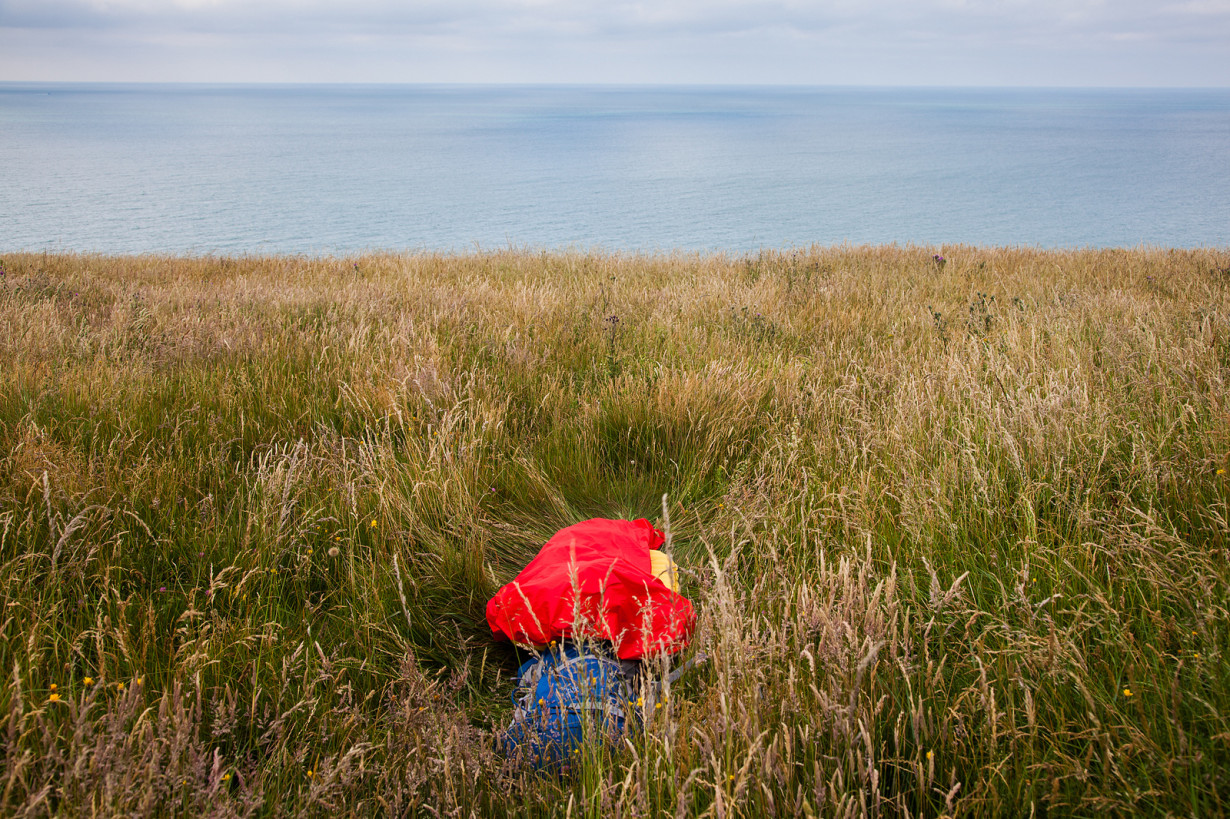
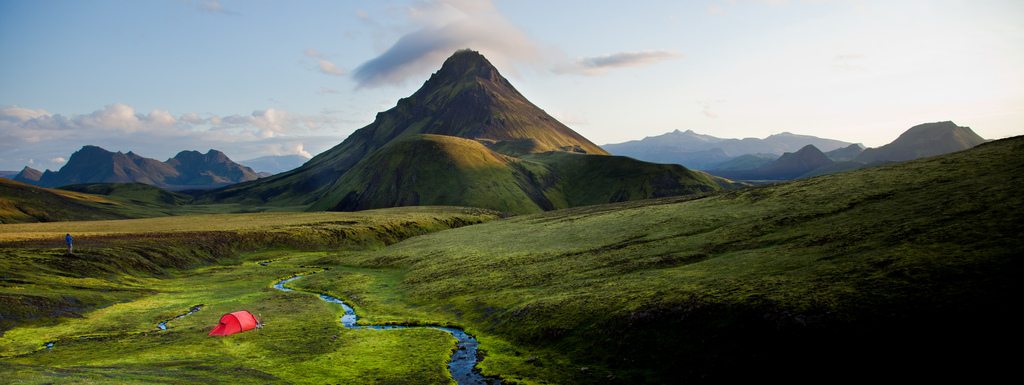
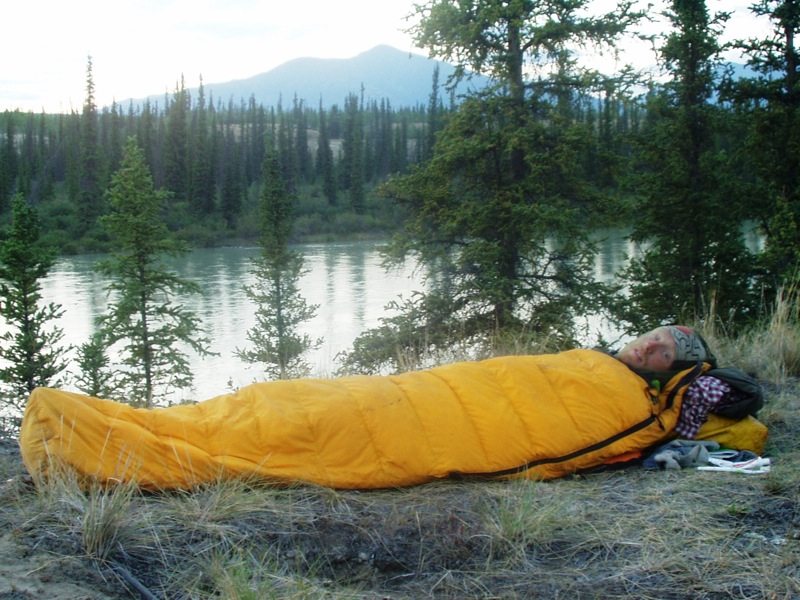


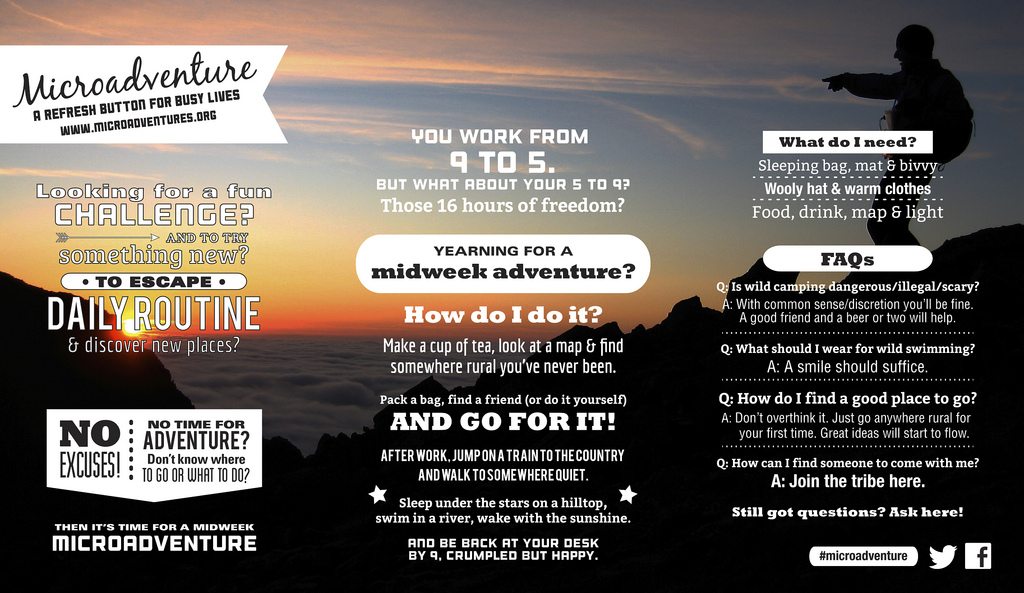
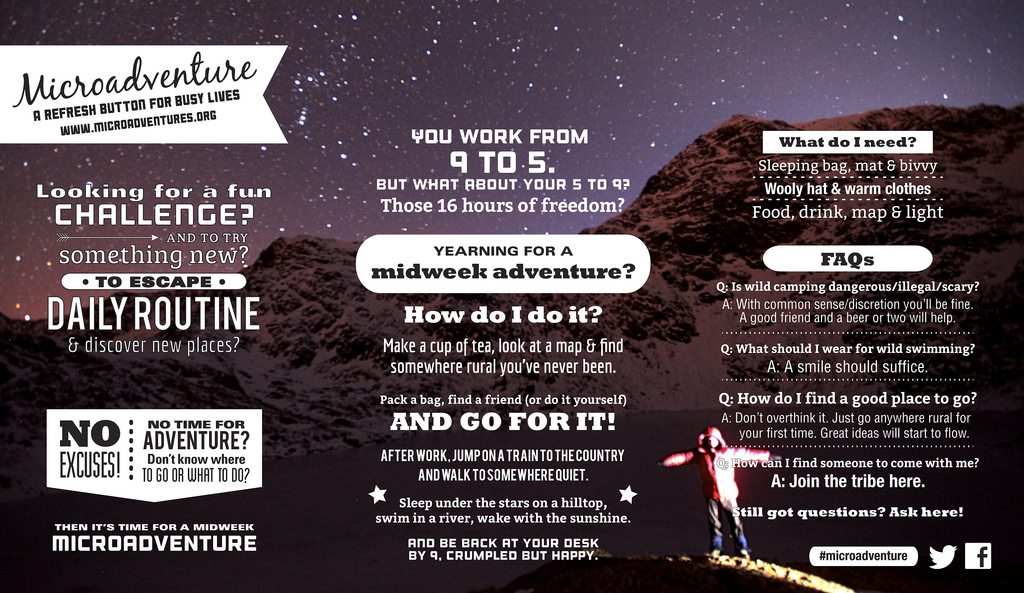

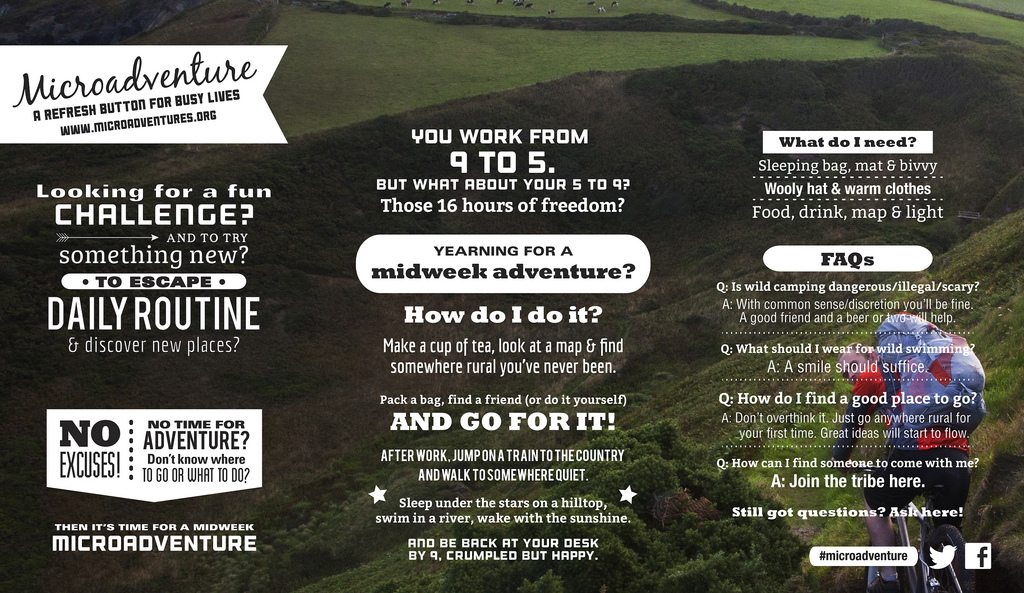


Great article Alastair and I agree with it entirely. My friends and I almost always bivvy when camping.
We’re quite fond of the late-notice microadventure we call the “stealth bivvy” – where you’ve everything packed except your sleeping bag – and you just pack away the sleeping bag into your pre-readied pack and go!
I recently wrote an article on the joy of more spartan adventures here:
http://www.hikersblog.co.uk/back-to-basics/
Looks like we’re thinking along the same lines 🙂
Good stuff. I would add that a tent lets you keep the nasty insects at bay. Having bivvied in Scotland and been eaten by midgies and had a similar experience in Germany where I was bitten on the face several times by “something” during the night I have reverted back to a small tent. A shame because otherwise it’s a great experience.
Agreed! This trip was torture due to midges and a bivvy – https://vimeo.com/27367534
man, Al Humphreys adventure + Frank Turner music, what a mix!
David, have you seen the bivvies with mosquito nets? I know the Terra Nova Jupiter has one (if you’re feeling flush). Google it or click the link on my name for info!
Good read! I have only ever used the military issue bags, which are, as you say, enormous! I have a friend who uses a much smaller (and more expensive!) Rab bivvy bag, and it is always wet on the inside due to condensation. Because of the larger size and increased airflow inside the good old issue bag, this never happens!
I agree that if space / weight is not an issue then the Army ones are the best.
Like the new web site! Good article too on bivi bags.
I used the Rab Survival Zone on my walk in Spain and loved the feeling of being connected to nature more so than in a tent. While there can be condensation some nights, I think the compact and light design cancels out this occasional problem.
For Scotland in Summer I agree that an enclosed small tent would be better. Tarptents may provide the compromise between a bivi and a tent to keep the midges away in Scotland …
http://www.tarptent.com/
Or you can make your own …
http://www.tarptent.com/projects/tarpdesign.html
Survival bags are also great for human toboganning! See: http://pnkt.me/SBnwF 🙂
Bivvy bagging is fun and cheap. My own is a Trekmates bought for £15 from TK-Max. Bit tight but works fine, when I could get out and use it.
One problem when you wear glasses, bit uncomfortable to wear them all night but if I do not I cannot see the stars very well and one does not want to miss a shooting star.
Night noises are oddly comforting, from the screech of an owl to the scream of a vixen, even the chomping of cattle on the downland grass when I was younger and made do with an old poncho and a sleeping bag made from an eiderdown.
I carry a small bit of tarp for those times that you get a downpour – just create a basic ‘A’ frame with some sticks and paracord and Bob’s your uncle. Obviously this means you can’t see the stars but I use an army bivi which doesn’t cover your face, so the tarp is always welcome in worse weather. When it’s fine, obviously there is no need!
Good pragmatic answer!
A belated congratulations for being Adventurer of the Year. 2012.
I decided that my trip was going to be the Cauvery River, in short try as I might. After looking online, Reading your book “There are other rivers” I’ve seen very little mention about the gear you took with you in your pack. I’d love to get a quick list to help me choose what to take … Like you, I’d like to travel similarly… light as possible.
In advance, your help is really appreciated.
Hey Alistair, have you ever tried a Swag on your adventures? They are like a super luxury bivvy, with enough room inside for your pack and usually a thin built-in mat or mattress thingy
No, but I’d like to try it sometime.
Thank you for getting me out of the tent! Sleeping under the stars is wonderful! The open air makes one feel alive.
The bivvy, however, I found claustrophobic and sweaty. I’d rather go without.
Watching Shug talking about hammocks at youtube, and due to the ticks that kept crawling up my legs, I choose to go hiking with a hammock, with a mosquito net, but without a tarp.
I loved the hanging. The hammock changed my view. Not longer I searched for an empty spot on the grass. Now I needed to find two strong looking trees, preferably a bit hidden, but not too dark and creepy.
I found the camping in the wild very adventurous. Especially when I read in an old newspaper that the police was looking for two thugs in the woods, the exact woods I was hiding. Good thing I read the news afterwards, otherwise I may have changed my mind.
After strolling for three days and two nights I became as nervous as the deer I startled on my way and I soo needed a shower. But I did it, on my own, in the over regulated and overpopulated Netherlands where the fine for camping in the wild is between 60 and 95 euro’s.
Showing them your blog I invite people with a garden to get out there and spend the night in their backyard. As a micro-microadventure. Less scary and yet so much fun!
I have found the Exped with PU floor as the best so far.
all the best
/Jerker
I have found the Exped with PU floor as the best so far.
http://www.exped.com/exped/web/exped_homepage_int.nsf/
all the best
/Jerker
After reading this entry I get hunka on alpkit.com. I’ts cool.
I really want to get started, but see very few options for Bivvy bags in USA. It seems like I am stuck between REI and Chinook, and most have pretty unimpressive reviews.
Any tips on online stores in america?
I’m afraid I don’t know.
What I would recommend is just buying something very cheap. Try it out for a few months and decide if you live bivvying enough to buy something good.
Seriously – the orange bag at the top of this post will be fine for you to begin with.
Good luck!
Al
The US military surplus ones are rated over four stars and are about $40 for new, less for used ones. I have not tried one …
Hey brother, I cycled down the Pacific Coast with an old highschool buddy of mine. He used a military grade bivy from a military surplus store the entire route. I suggest checking some of those places out. Hope that helps man.
Try to find a U.S. army issue sleeping system.. They have a gore tex bobby bag and multi layer system.. I use mine quite often and it’s kept me dry in the winter in wisconsin
Integral Designs
Hi Alastair,
Great post, getting out there with a bivvy bag is great. I love my tent but a bivvy gives you a better all round outdoor experience. Lying there enjoying the night sky is unbeatable (assuming it doesn’t rain) 🙂
Great site by the way. Thanks for sharing your adventures with us.
David 🙂
Hi Alistair,
Great website.
I’m really interested in giving this a go. I’m watching eBay for an army bivvy at the right price. I have a sleeping bag and I’m looking for a mat.
As I’m dipping my toe in the water I’m planning to use an aluminium camping mat. Think they’re about £5. Have you ever tried one. I’m hoping that if I pick soft ground then the aluminium mat might work well from the insulation point of view.
What do you think?
treat yourself to something a bit nicer!
That is for the plug Al!
Or, rather, “THANKS for the plug” (of my geeky bivvy bag comparison table: http://thenextchallenge.org/comparison-best-bivi-bags/)
Right on! Ive actually been using my $20 tent and sleeping bag together as a makeshift bivvy. I’ve realized that I would much rather sleep with the stars over my head than a tent covering. I just wrap my self up like a burrito and pass out like a baby. I sleep better this way, and since I free-camp, I feel l have a better sense of my surroundings where I can wake up and look around if I hear something, or want to make sure the coast is clear. And if it’s going to rain (this is for urban/semi urban environments) I just find a school, church, or abandoned building and they usually have extended roofs that provide some overhead shelter. The tent works fine for now, but once it’s outlived its usefulness, I’ll be buying a proper bivvy for sure.
Great piece, brother.
As a longtime hiker/camper I can see a gap in the bivi/tent market that needs plugging
Might be a bit over the top budget-vise, but I use the Caronthia observer. I used it with a carinthia defence 6 sleeping bag in minus 35 celsius, and I was warm and well rested the next day. Both are issued to me though….
There seem to be a range of bivvy bags now that are more like micro tents. Just about big enough for you to get into, but have some structure to them so they rest on top of the sleeping bag, at least at the head anyway.
Take the terra nova jupiter as an expensive example.
In terms of the way I travel I prefer a tent (i often have loads of motorcycle gear with me), but these type of bivvy bags are useful for emergency shelter, or when caught out in between cheap gueshouses in South America / Africa and the like.
Hey Mike, you’re certainly right about the hooped bivvies with more structure to them. There seem to be even more of them over in the US than here in the UK but we still have plenty.
I think the main advantages of the hooped bivvies is rain and bug protection. The downsides, obviously, are that they are not quite as good at the rest of the bivvy bag strengths e.g. quick pitch/strike, being discreet and not weighing very much.
hello I’m planning to spend a few nights out in the open and I have a bivvy bag is it good idea to use it as extra layer over my sleeping bag inside the tent ? I got a gore tex one off ebay surplus american army and so far only used it together with my tarp but never inside a tent.
thank you
luigi
you don’t need it in your tent at all, unless you are freezing cold.
climbing the highest mountain in ireland in a couple of weeks and snow is expected so i want to bring the bivvy in case temperature go down more than expected…
You can use one inside your tent as an extra layer in the cold. It might beat carrying around a bulky 4 season synthetic sleeping bag.
That being said, if you are going to be camping in freezing temperatures you’ll probabaly want a down bag anyway. They pack down night and small.
True indeed.
The only problem with down is it’s blooming expensive!!
The only problem with using a bivvy inside a tent is the lack of breathability. Even the good ones get very sweaty when they’re inside two layers of nylon tent.
If it’s cold then the sweat can freeze on the inside of your bivvy bag which gets messy – even less breathable and melts again onto your precious (down) sleeping bag.
If you’re carrying one anyway then you can always put it underneath your camping mat for extra warmth/protection.
Tim thanks for your reply very useful.
Pleasure!
Thanks, Tim!
Under £20, and with very good specs, but no mention of the fabric?
Sod it, ordered one anyway, I’ll let you know how I get on.
http://www.karrimor.com/karrimor-x-lite-bivi-bag-781084
fingers crossed!
I think I have this bivvy, is it dark green? They’ve stopped selling them I think, but I love it! It’s incredibly light and not too bad on the condensation front, I’m about to use it in a snow hole in the Cairngorms next week, so will let you know how I get on! What do you think of it?
I’ve used the Karrimor a couple of times on cold drizzly nights in the woods. Kept me dry, and very compact too.
Another budget model I recently spotted is from Decathlon, just over £20, gotta be better than a plastic bag!
http://www.decathlon.co.uk/waterproof-and-breathable-hiking-sleeping-bag-cover-grey-id_5424869.html
Trying a canvas sleeproll this year no idea how it will proceed 🙂
Hi,
Going to give bivvying ago for the first time on the South Downs next week with 2 of my unsuspecting pals. Being the generous guy I am, I’ve treated them both to a £5 survival bag each.
I havent unpacked these yet, thought I’d leave it for when we arrive, but my question is, I could only get double survival bags, are these going to be too big for one person? will this/has this caused anyone any problems in the past?
Great site AH and recently purchased your book, both very inspirational!
Thanks.
Steve
Too big is only a problem for the weight of carrying it.
The best option would be to ‘forget’ to bring one of the bags, and then tell them they have to share the remaining one!
Just picked up the Vaude “bivi” that includes a hoop over the head. Added ventilation and bug protection, as well as giving room for a book, will be much appreciated. Will be testing in Corsica for a few weeks if anyone’s interested.
A lot of people have awful trouble with midges and so did I, until a farmer friend told me of, “Avon, skin so soft”, amazing stuff, they don’t come near it, it’s the best insect repelent I’ve ever know, give it a go guys..
There is a solution to midges and insects, in Australia you get expensive bivvies. I spent over $300 on my bivvie and it has an insect flap and this amazing material called gammatex. You get what you pay for and in my opinion its best to get few but expensive gear. I love your site mate.
You suck
Thanks!
Found your site after researching an issue with my bivvy so hope you can shed some light. Was bivvying out in Cumbria this week photographing the lunar eclipse with my brother when I noticed my Rab Storm was covered in dew yet my brother’s Aplkit Hunka was perfectly dry. This moisture had migrated/formed inside too, getting my down bag quite damp. This happened the following night at a different location but similar conditions – clear night sky, air temp 8°C and hardly any wind. The materials used must be different but wondering why the big difference? I would have been better off not using any cover and may have to downgrade my kit from now on.
Hmmm. I have only two theories.
1. Is the Rab Storm really old?
2. Does it happen if you swap bags (ie is one of you sweatier than the other?!)
Other than that I don’t know – according to the price tag the Rab one should be much better…
That’s a really interesting dilemma Tim (if you’re a sad bivvy bag enthusiast like me).
I reckon it’d either be Al’s second point (one of you ‘glows’ more) or possibly that one of you was giving off more heat (by sleeping warmer and/or having a thinner sleeping bag). I never quite understand condensation but I think it happens when warm air hits something cold, right? So the temperature of your bivvy bag material would effect it.
That could, of course, be complete nonsense…
Thanks for the reply. Both bags only a year or two old and this issue happens before getting in so is not down to condensation from the body but from moisture in the air condensing on the outside of the bag as the temperature drops. Hmm, oh well, off to buy a new bag from Alpkit I suppose. By the way, where is the location of the image near the top of the page – red tent and mountain – it looks like a place I have to visit! Cheers.
I really am not a gear geek. I was going to say “you need to ask Tim Moss”, and then saw that he has already commented!!
How about a Dutch army hooped bivvy – mines very good.
It would be helpful on the comments if people (apart from AL) gave an actual short review of their bivvy experience rather than wank on about specs and gear. People don’t want the company marketing spiel repeated, they want to hear the actual experience. At the end of the day, you could survive most microadventures in one night sleeping in a few layers of clothes with a survival bag or a weatherproof synthetic sleeping bag – you don’t need the bivvy if it’s just one night. Our skin is waterproof, just make sure your mat is decent!
Hi Al,
Is the Alpkit Hunka still the best on the market (at its price range) in your opinion? I can’t find any recent reviews on t’interweb.
I foolishly handed back my loyal issued bivvy when I left the forces – some sort of stubborn principle against wearing green and sleeping in ditches! Thanks.
yes – it’s really good and value for money.
yes – really good and value for money.
Hi Al,
Encouraging and inspiring site. Definitely up for trying. It’s a whole new concept for me as I’ve always been a tent guy. Came across the site when looking up what bivvying was after seeing bivvy bags fire sale on tera nova.
Keen to visit that place pictured at the top! Where abouts was that?
Sorry I wasn’t specific. The picture with the red rent and the mountain peak!
Laugavegur Trail, Iceland…
Laugavegur Trail, Iceland…..
Appreciating the commitment you put into
your site and detailed information you present. It’s nice to come
across a blog every once in a while that isn’t the same unwanted rehashed information. Wonderful read!
I’ve saved your site and I’m including your RSS feeds to my Google account.
Looking at an army bivvy, but is 8 feet long apparently. Is it better to have big or small bivvy? Thanks!!
If you’re tall, go long!
Thanks. On its way and very excited!
Hey Alastair – I just stumbled across you here while making enquiries about bivvy bags. I didn’t know what a bivvy bag was but heard in the news that a Scottish couple were found alive and well yesterday after getting caught out in a storm in the Cairgorms. Mountain rescuers who found them said that it was their bivvy bags that saved them. Anyway, I just thought i’d drop you a line…..I was one of the crew on the yacht Maiden that you were on…..Cape Town to Rio 2003 yacht race…..remember?? Anyway, if you have a minute, drop me a line….it would be good to hear how/where you are?! Take care – John Dowson.
Hi John,
How great to hear from you again! That race was one of my favourite adventures – happy times indeed…
I’m doing the southwest coast path in a couple of weeks and was thinking of taking just a bivi tarp and hammock, as I have a small lightweight tent but it still feels to heavy, I’m thinking lighter faster and easier. It may take 6 weeks, any comments welcome.!
The big problem with a hammock is that you need two trees, correctly spaced, at the time you wish to camp. I’d go for bivvy, tarp, thermarest.
Hi Greg, the SWCP is excellent for bivvying but distinctly lacking in trees for tarps/hammocks. I’d normally say the choice is down to personal preference but on this occasion I’d definitely recommend a bivvy bag or tent rather than a hammock/tarp. Good luck!
Thanks Tim!
Great website Alastair. I used an Outdoor Research Helium Bivy for a third of the last year running around the coast of Britain, light, compact and waterproof. Im after a double that isn’t bright orange for discreet nights with the missis. Any sources?
Hi, apologies if this is covered elsewhere (I can’t find anything) .. Inspired by you I’ve used a bivvy a little bit and loved it – now my girls (9 and 10) are desperate to ride out and bivvy with me, (we’ve done many nights in the garden in sleeping bag with their duvets on top!) – but I’m not sure about bivvy bags for children? Is it ok just to use a normal one, I’ve read somewhere about kids getting sort of ‘trapped’ in them? Any experience, thoughts? Cheers, David
Hi David, I don’t know of kid-specific bivvy bags. If you’re worried you could always tie a knot in the bottom? Let me know how you get on!
Ah yes! Thanks – brilliantly simple: this is probably why you can make it round the world and I can barely make it to the end of the road without returning home twice for things I’ve forgotten.
It is a great solution, the bivvy will ‘grow’ with them too, as the knot gets lower down the bag – thanks
David
Haha! It is VERY rare that I have more common sense than anybody else!!!!
it can be worth taking an orange survival bag to go over your bivvy bag if its pouring for a couple of days and becomes a flood, gale force winds that can blow any tarp you put up away or turn it into a kite.Another w/p barrier and only about a fiver lots of people have them in the mountains anyway.
Ok yes! Much appreciated – splendidly basic: this is most likely why you can cause it round the world, and I to can scarcely make it as far as possible of the street without getting back twice for things I’ve overlooked.
It is an extraordinary arrangement, the bivvy will ‘develop’ with them as well, as the bunch gets let down the sack – much obliged.
David
One point missed and as an experienced micro-adventurer and current resident of the Highlands, is midges. You can not sleep with your face exposed if the midges are out and about. There are solutions such as bivvy bags with mesh net openings or simple mesh tent shelters Whatever your choice midges are not an insignificant issue that have to be bought into the equation.
YES YES YES YES!
Hi Alastair,
What a great read. I had no idea bivvy bags even existed. Well, I think I know my next purchase now!
Great site you have,
take care
Jamie
I’m a bit late to the party but this might be useful for other latecomers. Outdoor Research has superb bevy’s to deal with midges and the like. A couple of their models have mesh screens so you can see the sky and still be protected from the bugs. I used my Outdoor Research bivy a number of times and it was fantastic. Be prepared for some internal condensation sometimes.
I am a keen Bivvy user and currently have a UK Military Gortex Bivvy that I have modified with a bug net and tie out points.
On the subject of moisture build-up over successive rainy days, I have taken to always using sleeping bags with a synthetic fill. This way, even with a build up of moisture, the bag remains ‘mostly’ effective.
Okay so synth bags are heavier than down filled, and may not be popular with the Ultralight fans, but I’d take ‘warm enough but weighty’ over ‘light but shivering in the cold damp’ any day.